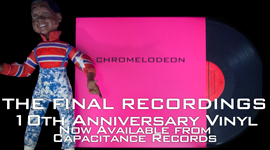Originally published on Philadelphia City Paper on November 10 2006. Written by A.D. Amorosi.
Kicking up Sawdust with avant-garde rockers Chromelodeon.
Philadelphia octet Chromelodeon manipulates its sound as if fiddling with an old-school joystick. It’s a music fraught with twitching and twirling, blipping and barking, theremin-fueled juking and blissing out within glacial cinematic space-capades. There is also, of course, a touch of kitsch in a chaos-driven orchestra named after instrument inventor Harry Partch’s quirky reed organ (hence the Sprite Slowdown offshoot, which dedicates itself to video game soundtracks). Either way Chromelodeon is a group that utilizes violins and accordions with the same ardor as guitars. But this band — best heard live, great on Bloodlink label CDs In the Year 20XX and the new Heart of Sawdust — is cluttered, clustered and hard, with little comparison to much else within avant-garde circles. One of its hairiest synth players (under the guise of anonymity and group expression) sat us down to tell us that the Chromelodeon sound is as hopped-up as he is on Sparks.
City Paper: What’s the biggest difference between 20XX and Sawdust?
Chromelodon: For Sawdust, we had a cohesive agenda. There was a soundtrack we wanted to present that had evolved from months of hard work and two U.S. tours as a trial run of the finished material. 20XX came at an early stage for the band — we had good songs in mind, but they just didn’t connect.
CP:How does the idea of Partch’s chromelodeon suit you guys?
C: A little-known fact is that Harry Partch was a big part-time bum, which applies to most of our group. Of course, he also had his personal take on how music should sound and honest to hell didn’t really care how other people interpreted or adapted his musical inventions.
CP: What’re the three most inspirational film soundtracks to the band’s way of thinking?
C: Cat People, Suspiria and Once Upon a Time in the West. They all have a particular emphasis in them, and are epic enough to stand alone. They tell a full story without words. Same thing with video games like the Ninja Gaiden series, the Megaman series and the Sonic the Hedgehog series. There are many games in each, but they all maintain a continuous feel.
CP: I hear the show on the 11th is a set of exclusively video-game covers. What game are you most into covering live?
C: We’ve had so many ideas for video-game arrangements we kind of had to form a side project for it [Sprite Slowdown]. We do a couple of rare performances per year. It’s very fun. Most of us respect the game Chrono Trigger to the extent we would never even consider covering it! But, the game Tetris is continually a huge focus of arguments and gambling, and additionally is applied in theory to the packing up of our trailer.
CP: When I listen to you, I always feel as if you’re studiously, theatrically trained. What gives?
C: Between the band and our visual collective, there are graphic artists and those involved with film and mass media. In a general sense, we’ve always been actively critical of the media, far more than just your usual level of sarcastic humor. This sort of explains our tongue-in-cheek approach to our sound and image. We think most people get the joke.

